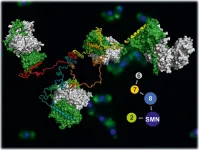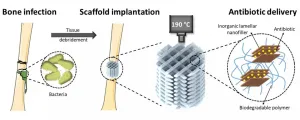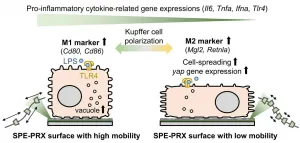First 3D images of a giant molecule
2021-03-24
(Press-News.org) SMN or in full Survival Motor Neuron: Professor Utz Fischer has been analyzing this protein and the large molecular complex of the same name, of which SMN is one of the building blocks, for many years. He holds the Chair of the Department of Biochemistry at the Julius-Maximilian's University of Würzburg (JMU), and he first discovered the molecule during his search for the root cause of spinal muscular atrophy. As scientists found out a few years ago, this disease is caused by a lack of the SNM complex.
The work group around Prof. Fischer has now succeeded in presenting a first three-dimensional model of the entire SNM complex. Once the structure of the complex is known, it is possible to understand the way how the complex works, and why the loss of its function leads to muscular atrophy. The scientists have published their findings in the current issue of the journal Nucleic Acids Research. The journal considers it to the a "Breakthrough Article".
The new findings have been made possible by an integrative structural-biological approach that combines biochemical, genetic and biophysical technologies.
Resolution up to a millionth of a millimeter
"The structural analysis of large and complex molecules in atomic detail has been made possible by the 'revolution-resolution', which was primarily brought about by the developments in cryo-electron microscopy", says Utz Fischer. The only snag about the technology, however, is the fact that it works best on structures that are more or less rigid and have few flexible sections.
Unfortunately, many molecular entities are not built like this, including the SMN complex. "This complex is of central importance for our cells because it supports the formation of molecular machines required for the expression of our genes", says Prof. Fischer. However, in order to serve its function in the cell, it must be highly flexible and dynamic. As a result, a structural analysis by traditional strategies has been impossible so far.
A combination of different methods was the key to success
Therefore the Fischer and his team chose an alternative approach: "Our starting point was a cooperation with the group of Dr. Rémy Bordonné from Montpellier in France, that enabled us to identify the SMN complex of the yeast Schizosaccharomyces pombe", he explains. This complex was ideally suited for an integrative structural analysis because it comprises less individual components than its human counterpart and has a less dynamic behavior.
"In a first step, we visualized, by X-ray diffraction analysis, individual sections that are important for keeping the complex together", says Fischer about the scientists' approach. In a second step, they characterized the entire complex and parts of it by means of small-angle X-ray scattering. This method also provides information on the dynamic behavior of unfolded sections of the complex. In parallel, missing sections were reconstructed by means of a bioinformatic method called 3D homology modeling.
This combination of different structural-biological methods will gain in importance in the future because it produces results that have never been achieved before - such is the conviction of Dr. Clemens Grimm. He is the Head of the "Structural Analysis" unit of Fischer's department, and has contributed to the recently published work.
An octopus with flexible arms
The result was a model of the entire SMN complex that provides an excellent explanation of its function. Similar as in an octopus, the central "body" of the complex has a number of long and very flexible "arms", which enable the complex to catch proteins and assemble them, together with other biomolecules, into molecular machines.
The model also provides insight into the processes that lead to spinal muscular atrophy. "The mutations causing this disease concentrate in the central body" explains Fischer's doctoral student Jyotishman Veepaschit, who performed experiments of this study together with his colleague Aravindan Viswanathan. They prevent the full development of the complex, so that it cannot serve its function in the cell.
INFORMATION:
About Spinal Muscular Atrophy
Spinal muscular atrophy is a congenital disease that can appear in children, adolescents and adults with symptoms of variable severity. In its most severe forms, the patients affected by it die as early as infancy from the consequences of muscular weakness and progressive paralysis. In other cases, medical care including physiotherapy and orthopedic aids can preserve their mobility and vitality for quite some time.
Spinal muscular atrophy is not rare: It affects about one of 6,000 persons. Due to a genomic mutation, such persons suffer from a lack of the protein SMN. This lack manifests itself especially in the nerve cells that control muscle movements. These cells, known as motor neurons, lose their contact with the muscle and die.
[Attachments] See images for this press release:

ELSE PRESS RELEASES FROM THIS DATE:
2021-03-24
In a ground-breaking first, researchers have fabricated 3D scaffold implants containing antibiotics at high temperatures. These scaffolds not only support bone regeneration but manage the bone infections that can arise as a result of injury or surgery.
Each year, around 4 million people worldwide develop bone infection following an open fracture or surgery. The gold standard treatment consists of a lengthy antibiotic therapy, usually delivered orally or Intravenously, and the removal of infected bone tissue, which often leaves behind a hole too large for the body to fill via normal bone regeneration. In a study published in the KeAi journal Bioactive Materials, a group of researchers from the Netherlands, Italy and Spain, outline a new treatment ...
2021-03-24
A genetic variation that regulates iron metabolism may enhance athletes' endurance performance, researchers at the University of Toronto have shown.
The findings could help explain studies that show an association between the genetic variation and elite athletes across many sports, and may help competitive athletes fine-tune their iron intake to boost performance.
The variation, found in the homeostatic iron regulator (HFE) gene, is a known cause of iron overload, a condition called hemochromatosis in which the body absorbs too much iron leading to organ and joint damage.
Athletes at risk for hemochromatosis but with iron stores below potentially toxic levels could have ...
2021-03-24
Bacteria plucked from a desert plant could help crops survive heatwaves and protect the future of food.
Global warming has increased the number of severe heatwaves that wreak havoc on agriculture, reduce crop yields and threaten food supplies. However, not all plants perish in extreme heat. Some have natural heat tolerance, while others acquire heat tolerance after previous exposure to higher temperatures than normal, similar to how vaccines trigger the immune system with a tiny dose of virus.
But breeding heat tolerant crops is laborious and expensive, and slightly warming entire fields is even trickier.
There is growing interest in harnessing microbes to protect plants, and biologists have shown that root-dwelling bacteria can help their herbaceous ...
2021-03-24
Researchers from Tokyo Medical and Dental University (TMDU) identify biomaterials that can be used to modulate liver immune cell behavior
Tokyo, Japan - Biomaterials are substances, natural or manmade, that are used in medicine to interact with the human body for various purposes, such as wound healing and tissue regeneration. Previous work on biomaterials has shown that they can affect cells in many ways, including how they grow, move, and the type of cell they develop into. Scientists have recently begun investigating biomaterials with properties that can be fine-tuned to optimize their use in regenerative ...
2021-03-24
Usually scaled, the skin of fish can also be naked or made up of bony plates that form an armour, sometimes even covered with teeth. But how has this skin evolved over the ages? To answer this question, researchers at the University of Geneva (UNIGE), Switzerland, have reconstructed the evolution of the protective skin structures in fish, going back to the common ancestor of ray-finned fish, more than 420 million years ago. They found that only fish that had lost their scales were able to develop a bony armour, and that the protective state of their skin influenced their choice of open water or sea floor habitats. This study, published in the journal Evolution Letters, provides a new explanation for the incredible ...
2021-03-24
In spring 2020, when the first wave of the coronavirus pandemic hit Finland, older adults drastically reduced their out-of-home activities. During the period of government restrictions, physical exercise was the most common reason to leave home, a recent study at the University of Jyväskylä Faculty of Sport and Health Sciences finds.
"In spring 2020, it was feared that the closure of many activity destinations and the recommendations to avoid close contact with persons from other households put in place by the government would decrease physical activity levels, and thus, negatively affect older adults' physical functional capacity," Senior ...
2021-03-24
The tiger shark is one of the largest predatory sharks known today. This shark is a cosmopolitan species occurring in all oceans worldwide. It is characterized by a striped pattern on its back, which is well marked in juveniles but usually fades in adults.
The fossil history of modern sharks reaches back to the Permian, about 295 million years ago. Complete fossil shark skeletons are very rare - the skeleton, which consists almost entirely of cartilage, is only preserved under very special circumstances during the fossilization processes. Due to the lifelong continuous tooth replacement, most extinct sharks are therefore only known by their well-mineralized teeth, which, nonetheless, can provide deep insights into their evolutionary history.
The ...
2021-03-24
Heavy elements known as the actinides are important materials for medicine, energy, and national defense. But even though the first actinides were discovered by scientists at Berkeley Lab more than 50 years ago, we still don't know much about their chemical properties because only small amounts of these highly radioactive elements (or isotopes) are produced every year; they're expensive; and their radioactivity makes them challenging to handle and store safely.
But those massive hurdles to actinide research may one day be a thing of the past. Scientists at the U.S. Department of Energy's Lawrence Berkeley National Laboratory (Berkeley Lab) and UC Berkeley have demonstrated how a world-leading ...
2021-03-24
Nonalcoholic fatty liver disease (NAFLD) is a pathological condition characterized by excessive fat stored in the liver that is not attributed to heavy alcohol consumption, which can lead to liver failure and even cancer. Obesity, type 2 diabetes, and high cholesterol levels are all risk factors for this disease, and like the global prevalence of obesity, the prevalence of NAFLD is coincidently expected to rise as well.
It is therefore critical for clinicians to handle effective tools for diagnosing NAFLD. The current standard method for diagnosis is analysis of liver biopsy ...
2021-03-24
Researchers led by TMDU fabricate a material that will aid bone healing, help medical practitioners clearly assess the full damage to bones after an injury, and clarify probable patient outcomes
Tokyo, Japan - Bone repair wasn't generally successful until the late 1800s. Until then, there were few options to repair major bone damage. Most materials don't have the functionality of bone and don't support blood vessels growing through them. Repair materials such as clay were commonly used yet often failed. In 1892, medical practitioners started using gypsum--calcium ...
LAST 30 PRESS RELEASES:
[Press-News.org] First 3D images of a giant molecule









